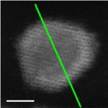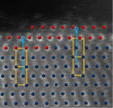- Home
-
Research Groups
Division Groups
- Artificial Photosynthesis
- Catalysis: Reactivity & Structure
- Electrochemical Energy Storage
- Electron- and Photo-Induced Processes for Molecular Energy Conversion
- Neutrino and Nuclear Chemistry
- Surface Electrochemistry and Electrocatalysis
Associated Groups
- Catalysis for Alternative Fuels Production
- Nanostructured Interfaces for Catalysis
- Structure and Dynamics of Applied Nanomaterials
- People
- Operations
- News
- Events

Surface Electrochemistry and Electrocatalysis
Synthesis of single crystalline Ru@Pt core-shell nanoparticles


Atomic resolution STEM (CFN) shows crystalline order for Pt shell (red dots)
on Ru core nanocrystals (blue dots).
Fabricating subnanometre-thick core-shell nanocatalysts is effective for obtaining high surface area of an active metal with tunable properties. The key to fully realize the potential of This approach is a reliable synthesis method to produce atomically ordered core-shell nanoparticles. Here we report new insights on eliminating lattice defects in core-shell syntheses and opportunities opened for achieving superior catalytic performance. Ordered structural transition from ruthenium hcp to platinum fcc stacking sequence at the core-shell interface is achieved via a green synthesis method, and is verified by X-ray diffraction and electron microscopy techniques coupled with density functional theory calculations. The single crystalline Ru cores with well-defined Pt bilayer shells resolve the dilemma in using a dissolution-prone metal, such as ruthenium, for alleviating the deactivating effect of carbon monoxide, opening the door for commercialization of low-temperature fuel cells that can use inexpensive reformates (H2 with CO impurity) as the fuel.
We developed a scalable green-synthesis method that produces single crystalline Ru@Pt nanoparticles with uniform Pt shell 1 to 3 atomic layers thick. Ru cores were found disordered in previously synthesized Ru@Pt core-shell nanoparticles based on much weakened Ru XRD intensities. In the absence of surfactant and metal template, we synthesized Ru cores with narrow particle size distribution and coated them with a uniform Pt shell using solvent ethanol as the reductant via fine tuning its reducing power. Via in-depth structural analysis coupled with DFT calculations, we identified the cause as defect-induced partial alloying, which resulted in smaller Ru cores with thicker Pt-rich shells. By minimizing the defects in the Ru cores and fine-tuning the conditions for Pt coating, we avoided partial alloying and demonstrated an ordered hcp-fcc phase transition at the Ru-Pt core-shell interface. Attaining a sharp, uniform core-shell interface is crucial for optimizing activity via tuning Pt-shell thickness and for protecting the Ru core from dissolution at high potentials.
Nature Comm. 2013 DOI: 10.1038/ncomms3466




